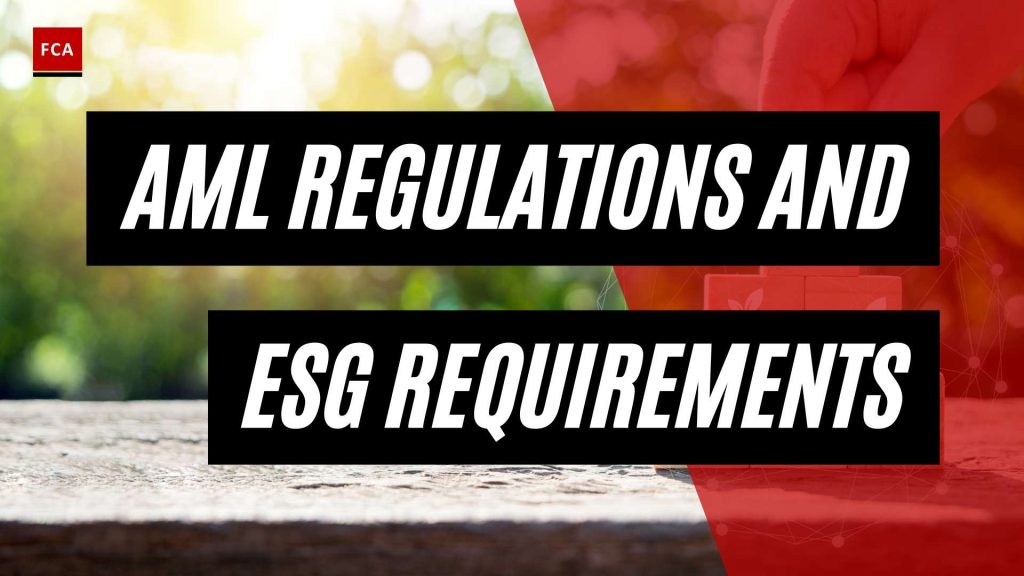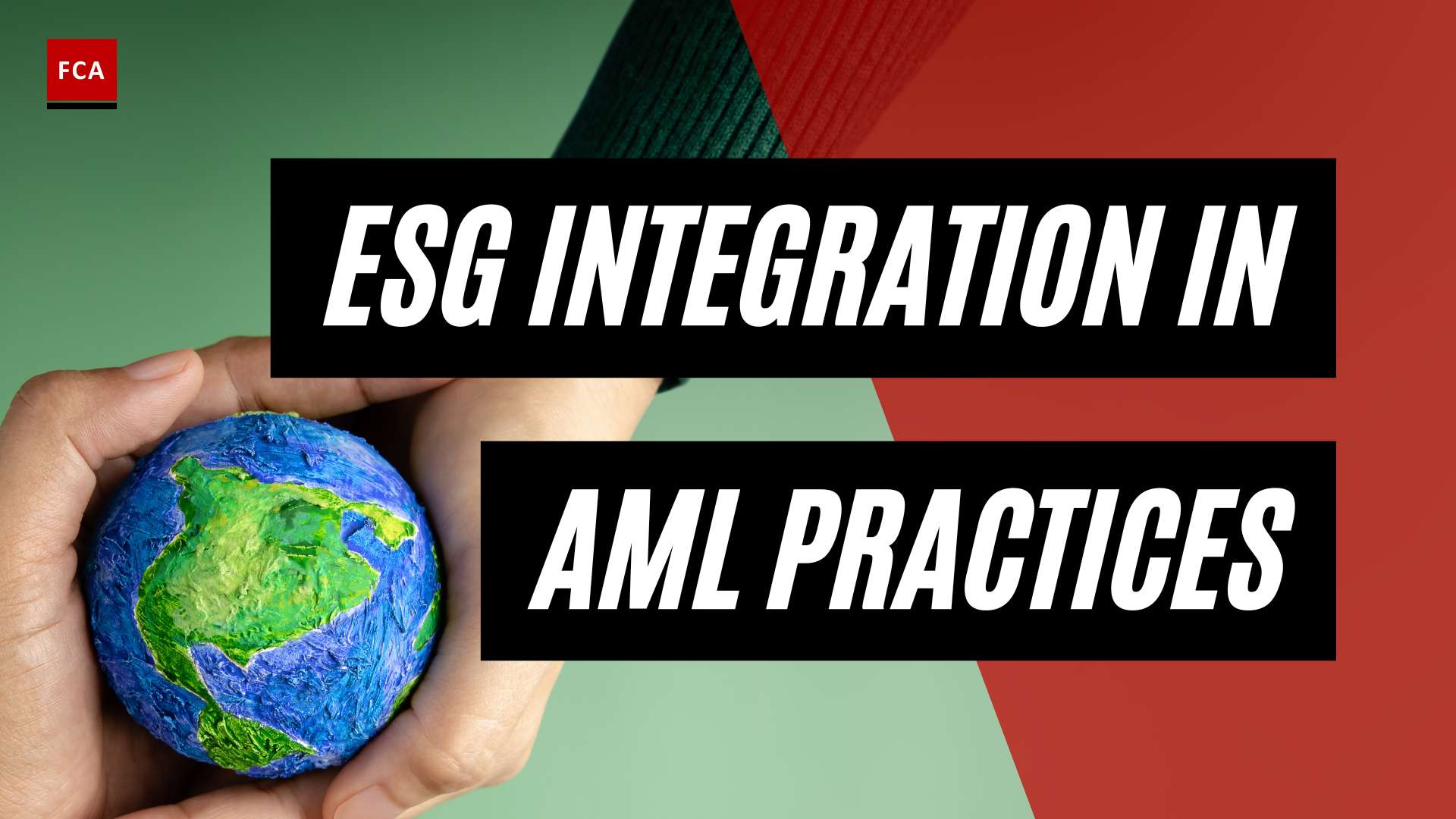The Intersection of AML and ESG
When examining the compliance landscape, it becomes evident that anti-money laundering (AML) regulations and environmental, social, and governance (ESG) requirements are two key areas that increasingly intersect. AML regulations are aimed at preventing money laundering, while ESG requirements focus on environmental, social, and governance criteria, highlighting the convergence of these two areas as important considerations for financial institutions.
Understanding AML Regulations
AML regulations are designed to combat money laundering and the financing of illicit activities. Financial institutions are required to implement robust AML frameworks to detect, prevent, and report suspicious transactions. These regulations typically involve measures such as customer due diligence (CDD), transaction monitoring, and reporting of suspicious activities.
The regulatory landscape for AML is governed by various international and national bodies, including the Financial Action Task Force (FATF) and local regulatory authorities. These regulations aim to protect the integrity of the financial system and safeguard against the risks associated with money laundering and terrorism financing.
Exploring ESG Requirements
ESG requirements, on the other hand, focus on the environmental, social, and governance aspects of business operations. Companies are increasingly expected to consider not only their financial performance but also their impact on the environment, society, and corporate governance.
ESG initiatives encompass a wide range of factors, including environmental sustainability, social responsibility, diversity and inclusion, human rights, labor standards, and ethical business practices. Investors, stakeholders, and regulators are placing greater emphasis on companies’ ESG performance and disclosures.
To meet ESG requirements, financial institutions need to integrate ESG considerations into their risk management frameworks, reporting mechanisms, and decision-making processes. This includes assessing the ESG risks associated with their clients, investments, and business practices.
By understanding both AML regulations and ESG requirements, financial institutions can navigate the complex compliance landscape and address the evolving expectations of regulators and stakeholders. The convergence of AML and ESG necessitates a holistic approach to compliance, where financial institutions need to strike a balance between mitigating financial crime risks and promoting sustainable and responsible business practices.
For more insights into how AML and ESG converge, let’s explore the impact of AML on ESG and vice versa in the next section, “How AML and ESG Converge.”
How AML and ESG Converge
The convergence of Anti-Money Laundering (AML) regulations and Environmental, Social, and Governance (ESG) requirements is becoming increasingly important in today’s financial landscape. Understanding the impact of AML on ESG and vice versa is crucial for professionals working in compliance, risk management, and anti-financial crime.
AML’s Impact on ESG
AML regulations are now being leveraged to address ESG issues, highlighting the critical link between the two. Legislators are using AML laws, such as sanctions regulations, to guide the identification and avoidance of dealings with rogue political regimes, terrorist groups, and entities involved in human rights violations, such as forced labor and human trafficking. By incorporating ESG considerations into AML regulations, financial institutions can better identify and mitigate risks related to environmental, social, and governance factors.
One way AML impacts ESG is through enhanced due diligence measures. Financial institutions are implementing robust processes to assess the ESG risks associated with companies operating in sensitive industry sectors. Additionally, updating Know Your Customer (KYC) processes and customizing transaction monitoring parameters can help identify potential ESG-related illicit activities. Strengthening sanctions screening lists with ESG considerations is another action that financial institutions are taking to address ESG bad actors.
ESG’s Influence on AML
ESG requirements also play a significant role in shaping AML practices and regulations. The National Money Laundering Risk Assessment highlights the importance of integrating ESG risk considerations into AML frameworks. By doing so, financial institutions can enhance their ability to comply with AML regulations while addressing ESG risks.
Incorporating ESG considerations into AML regulations helps identify illicit financial activities that may undermine ESG principles. Understanding these risks allows institutions to take appropriate measures to prevent money laundering and other financial crimes associated with ESG-related activities. By considering ESG factors in AML investigations, institutions can better identify suspicious transactions and monitor for potential ESG-related risks (U.S. Department of the Treasury).
The convergence of AML and ESG is a critical development in the financial industry. Integrating ESG considerations into AML regulations and practices enables institutions to align their efforts in combating financial crime with their commitment to environmental sustainability, social responsibility, and good governance. This convergence facilitates a comprehensive approach to risk management and compliance, ensuring that financial institutions address both AML and ESG risks effectively. By bridging the gap between AML and ESG, institutions can contribute to a more sustainable and responsible financial ecosystem.
Regulatory Developments in AML and ESG
As the fields of Anti-Money Laundering (AML) and Environmental, Social, and Governance (ESG) continue to evolve, regulatory developments play a crucial role in shaping compliance requirements and expectations. In this section, we will explore the AML Act of 2020 and its implications for ESG, as well as highlight key regulatory actions and penalties.
AML Act of 2020 and ESG Implications
The AML Act of 2020 introduced significant changes to AML regulations, including provisions that have implications for ESG. For instance, Section 6110 of the Act focuses on Arts and Antiquities, aiming to strengthen anti-money laundering efforts in this area (FinCEN). By addressing potential money laundering risks associated with the arts and antiquities market, this provision aligns with the broader goals of ESG integration in AML.
Another noteworthy aspect of the AML Act of 2020 is Section 6206, which requires the Financial Crimes Enforcement Network (FinCEN) to periodically publish threat pattern and trend information derived from Bank Secrecy Act (BSA) filings. These reports emphasize the importance of information filed by financial institutions in accordance with the BSA to combat financial crimes effectively. This transparency and sharing of information align with the goals of ESG reporting and accountability.
Furthermore, Section 6212 of the AML Act of 2020 initiated the Suspicious Activity Report (SAR) Sharing Pilot Program, emphasizing collaborative efforts to enhance information sharing and counter financial crimes more effectively (FinCEN). This collaborative approach resonates with the principles of ESG, which highlight the importance of stakeholder engagement and cooperation.
The AML Act of 2020 also includes Section 6216, which mandates a review of regulations and guidance pertaining to anti-money laundering efforts. This review seeks to gather insights and feedback to identify potential improvements in AML regulations. This focus on ongoing evaluation and adaptability aligns with the dynamic nature of ESG requirements, which continually evolve to address emerging risks and challenges.
Regulatory Actions and Penalties
In 2023, regulatory authorities continued to emphasize the need for financial institutions to integrate ESG factors into their AML compliance programs (Paul, Weiss, Rifkind, Wharton & Garrison LLP). This emphasis reflects the growing recognition that ESG risks can have significant implications for AML compliance and overall risk management.
Throughout the year, regulatory actions and penalties against financial institutions for non-compliance with AML regulations remained a focal point. These actions served as a reminder of the importance of maintaining robust AML programs and adhering to regulatory requirements (Paul, Weiss, Rifkind, Wharton & Garrison LLP). Financial services companies faced increasing pressure to address AML and sanctions risks associated with emerging technologies, such as cryptocurrency, requiring innovative compliance solutions (Paul, Weiss, Rifkind, Wharton & Garrison LLP).
These regulatory actions and penalties reflect the ongoing commitment to combating money laundering and financial crimes. They also highlight the importance of integrating ESG considerations into AML compliance programs to effectively address the evolving risks and challenges in the financial sector.
To navigate the complex landscape of AML and ESG compliance, financial institutions must stay informed about regulatory developments, adapt their strategies accordingly, and prioritize the integration of ESG factors into their AML frameworks. By doing so, they can contribute to a more sustainable and resilient financial system while effectively mitigating the risks associated with money laundering and financial crimes.
Integrating AML and ESG Compliance
Achieving compliance with both Anti-Money Laundering (AML) regulations and Environmental, Social, and Governance (ESG) requirements is a complex task that requires a comprehensive approach. Integrating AML and ESG compliance involves overcoming various challenges and considering specific factors, including the role of Know Your Customer (KYC) systems.
Challenges and Considerations
Adhering to ESG principles poses an additional challenge to businesses already striving to comply with anti-money laundering laws. While a business transaction might appear low risk financially, it could face scrutiny under the broader ESG lens, necessitating judgment by compliance professionals. This requires a deeper understanding of the environmental and social risks associated with a transaction, going beyond traditional financial indicators.
Integrating AML and ESG compliance also requires businesses to align their internal processes and systems. This includes integrating data sources, establishing effective risk assessment methodologies, and implementing robust reporting mechanisms. Compliance teams need to collaborate and share information to ensure a holistic understanding of both AML and ESG risks.
Another consideration is the need for ongoing monitoring and due diligence. With ESG considerations, businesses must continually assess their activities against evolving ESG standards and metrics. This involves monitoring not only financial transactions but also the social and environmental impacts of their operations. Compliance professionals must stay informed about emerging ESG trends and ensure their organizations are aligned with evolving standards.
Role of Know Your Customer (KYC) Systems
“Know Your Customer” (KYC) systems play a critical role in maintaining high standards for compliance professionals in both ESG and AML considerations, facilitating sustainable operational efficiencies while safeguarding a company’s social and environmental reputation. KYC processes involve verifying the identity of customers, assessing their risk profiles, and monitoring their activities for suspicious behavior.
In the context of ESG, KYC systems can be enhanced to incorporate ESG screening and due diligence. This involves assessing the social and environmental impact of customers, suppliers, and business partners. By integrating ESG criteria into the KYC process, businesses can identify potential risks related to environmental crimes, labor practices, human rights violations, and other ESG concerns.
Furthermore, KYC systems can enable businesses to collect and analyze ESG data for reporting purposes. By capturing relevant ESG metrics and integrating them into their compliance processes, organizations can demonstrate their commitment to ESG principles and meet reporting obligations.
Integrating AML and ESG compliance through KYC systems requires robust technology solutions that can handle vast amounts of data and facilitate efficient risk assessment. Automation and artificial intelligence can enhance the effectiveness of KYC processes by reducing manual efforts, improving accuracy, and detecting potential risks more effectively.
By leveraging the capabilities of KYC systems and adapting them to incorporate ESG considerations, businesses can streamline their compliance efforts and address both AML and ESG requirements more effectively. This integration not only helps organizations meet regulatory obligations but also demonstrates a commitment to sustainable and responsible business practices.
In the next section, we will explore the benefits of integrating AML and ESG compliance, including the synergies and cost savings that can be achieved, as well as the long-term success in a changing business landscape.
The Benefits of AML-ESG Integration
As organizations navigate the complex landscape of anti-money laundering (AML) regulations and environmental, social, and governance (ESG) requirements, integrating these two areas can provide numerous benefits. This section explores the synergies and cost savings associated with AML-ESG integration, as well as the long-term success it can bring in a changing business environment.
Synergies and Cost Savings
Integrating AML and ESG compliance efforts can create synergies that enhance risk management practices and promote responsible business conduct. By aligning these two areas, organizations can streamline their compliance activities and leverage shared resources. This integration can result in significant cost savings and operational efficiencies, as noted by HLB Global.
Combining AML and ESG activities allows organizations to adopt a more comprehensive approach to addressing financial crime and sustainability risks. By leveraging existing compliance frameworks, processes, and technologies, companies can avoid duplication of efforts and achieve greater efficiency in their compliance programs. This holistic approach not only helps organizations meet regulatory requirements but also demonstrates their commitment to responsible and sustainable business practices.
Long-Term Success in a Changing Landscape
In today’s business landscape, the integration of AML and ESG is becoming increasingly important for long-term success. Companies that fail to adopt ESG principles may face reputational damage, regulatory sanctions, and loss of investor trust, all of which can be detrimental to their business operations (HLB Global). On the other hand, embracing ESG principles allows organizations to proactively address environmental and social risks, meet evolving stakeholder expectations, and enhance their overall sustainability performance.
ESG standards are not merely an additional benefit to customers but are increasingly expected in the modern world. Research by McKinsey in 2022 found that ESG correlates positively with financial performance, suggesting that it is not a barrier to revenue creation but rather a driver of sustainable financial results (First AML). By integrating AML and ESG, companies can position themselves as responsible actors in society, attracting investors, customers, and other stakeholders who value sustainable practices.
In a rapidly evolving regulatory landscape, organizations that successfully integrate AML and ESG compliance efforts are better equipped to adapt to changing requirements. By staying ahead of regulatory developments and anticipating emerging trends, companies can proactively manage risks and seize opportunities. This proactive approach enables organizations to navigate the complex interplay between AML regulations and ESG requirements, positioning them for long-term success.
By integrating AML and ESG compliance, organizations can achieve synergies, cost savings, and long-term success. This integration promotes responsible business conduct, enhances risk management practices, and demonstrates a commitment to sustainable and ethical business practices. In a world that increasingly values ESG principles, the integration of AML and ESG is not only beneficial but essential for organizations looking to thrive in a changing landscape.
Case Studies: AML and ESG in Practice
To understand how the intersection of anti-money laundering (AML) regulations and environmental, social, and governance (ESG) requirements plays out in practice, it is insightful to examine the actions taken by financial institutions and the development of sustainable compliance solutions.
Financial Institutions’ Actions
Financial institutions have been actively taking measures to align their AML efforts with ESG considerations. This includes implementing enhanced due diligence for companies operating in sensitive industry sectors, updating KYC (Know Your Customer) processes, customizing transaction monitoring parameters, enhancing suspicious activity reporting (SAR) narratives with ESG considerations, and strengthening sanctions screening lists to address ESG-related risks and bad actors.
By incorporating ESG factors into their AML frameworks, financial institutions aim to ensure that their operations are in line with sustainable and ethical practices. This holistic approach allows them to assess the potential risks associated with environmental impacts, social responsibility, and governance issues while combating money laundering and illicit financial activities.
Sustainable Compliance Solutions
To effectively manage AML regulations and ESG requirements, financial institutions are turning to RegTech companies that specialize in developing sustainable compliance solutions. These innovative technologies help streamline and automate compliance processes, enabling organizations to balance AML and ESG principles effectively (Youverify).
RegTech companies listed as 2023 RegTech100 companies, such as Youverify, are at the forefront of providing cutting-edge solutions for sustainable compliance in the financial sector. These solutions leverage advanced technologies like artificial intelligence, machine learning, and data analytics to enhance risk assessment, due diligence, and data analysis, aligning AML and ESG efforts (Youverify).
By adopting such RegTech solutions, financial institutions can achieve greater operational efficiency, reduce compliance costs, and effectively address the evolving landscape of AML regulations and ESG requirements. These technologies enable organizations to enhance their risk management capabilities, identify potential ESG risks, and ensure compliance across the board.
Incorporating ESG considerations into AML compliance not only helps financial institutions meet regulatory obligations but also promotes ethical and sustainable business practices. By leveraging technology and adopting sustainable compliance solutions, financial institutions can navigate the complexities of AML regulations and ESG requirements, contributing to a more socially and environmentally responsible financial ecosystem.
The Future of AML and ESG
As Anti-Money Laundering (AML) regulations and Environmental, Social, and Governance (ESG) requirements continue to evolve, it is important to consider the emerging trends and outlook for their intersection. Recognizing the need to address ESG risks, regulatory authorities are emphasizing the integration of ESG factors into AML compliance programs (U.S. Department of the Treasury).
Emerging Trends and Outlook
The National Money Laundering Risk Assessment emphasizes the importance of integrating ESG considerations into AML regulations and practices to enhance an institution’s ability to comply with AML requirements (U.S. Department of the Treasury). As businesses face increasing pressure to address AML and sanctions risks associated with emerging technologies like cryptocurrency, innovative compliance solutions are necessary.
In the future, we can expect further harmonization of AML requirements, particularly in the European Union, as the proposed AML Authority represents a pivotal development in EU AML enforcement. This harmonization will contribute to a more consistent approach to AML and ESG compliance across borders.
Importance of Addressing Risks
Integrating AML and ESG compliance efforts is essential for organizations to enhance their risk management practices and demonstrate a commitment to responsible business conduct (HLB Global). Companies that fail to adopt ESG principles may face reputational damage, regulatory sanctions, and loss of investor trust, all of which can be detrimental to their business operations (HLB Global).
By addressing both AML and ESG risks, organizations can improve their overall sustainability performance. This integration allows for a more comprehensive approach to addressing financial crime and sustainability risks, positioning companies for long-term success in a rapidly evolving regulatory landscape (HLB Global). Synergies found in compliance activities can result in cost savings, operational efficiencies, and a stronger risk management framework.
To stay ahead, organizations should proactively monitor emerging trends and regulatory developments in both AML and ESG. By aligning their compliance programs with evolving requirements, businesses can adapt to changing expectations and effectively navigate the complex landscape of AML and ESG integration.
As AML regulations and ESG requirements continue to converge, it is evident that addressing ESG risks is crucial in the fight against financial crime. By integrating ESG considerations into AML practices, organizations can foster sustainable compliance, mitigate risks, and demonstrate their commitment to responsible business conduct.








